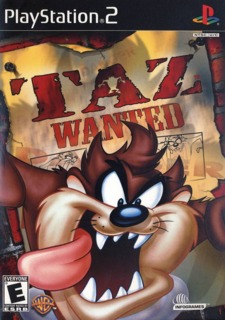Not quite there...
Before I start dissecting the game a quick warning - this game is for people who like (and I mean really like) platformers, have massive patience, and love the details of this piece of work inspired by Looney Tunes cartoons and characters. Everyone else - it might be a tough nut to crack unfortunately.
First thing the player notices upon the start of the game is the fact that the game is a rather direct port from PS2/Xbox to the PC. The controls definitely work after a couple of minutes of playtime and there is support for gamepads but without the latter one could feel somewhat constrained by keyboard buttons if not 'trained' to perform in such situations. The camera and its movement is the most frustrating thing in the entire game, which often makes a simple task incredibly difficult as it requires camera a mixture of player+the automatic camera adjustments. The camera is fixed over Taz' head and often shifts to the worst possible place at the worst time, the first-person view which is provided to help in these situations is helpful to some extend - but ultimately fails to provide any compensation for the strange general camera positioning.
Gameplay itself is pretty simple Taz must destroy a number of wanted posters of him placed by the villain of the game Yosemite Sam in a certain level to be able to progress in the game. These posters come in a variety of shapes and forms requiring some extravagant ways to destroy them. This basic platformer is enhanced by some particular actions that Taz can cause to the environment. Our lead character can eat and then spit most destructible (but not edible) objects and he can also spin causing massive devastation as well as overcome some obstacle. The game features places that Taz can 'disguise' himself thus enabling unique actions for each level that are used to dispose of persons attempting to apprehend Taz.
Upon destroying posters Taz earns money on his bounty that help him unlock the Secrets/Mini Games sections of the game. The mini-games have 2 layers: first the player needs to accomplish certain tasks in a level (get 100 sandwiches/ destroy 50% of destructible environment and find a golden statue) which then leads to the second layer - the unlockable secrets and mini games. (Spoiler Alert) These mini games are also 2 types - either checkpoint race or destroy number of boxes. The mini games are usually not very easy and somewhat frustrating, and unfortunately the only use of those is if you need to get more bounty to unlock secret galleries.The secret galleries include cartoon drawings of the environment or engine-based pictures of Taz which though somewhat interesting are not a big incentive to keep the gamer pressing for maximum score.(End Spoiler)
The cutscenes use the graphics engine and there is no differentiation between game footage and cutscenes. Which is a good thing as the graphic has a particular appeal that would be appreciated by real fans of Looney Tunes, but may be dismissed as lack of creativity by the developers by a more pretentious gamer.
The environment blends beautifully drawn flat animations with more detailed cartoon style objects. And these details make the whole game worth while - upon destroying something instead of pixelated parts of a crate for example, the game throws cartoon drawn 'pieces' of the object which is a nice touch and leans positively to the origin of the character. The level design may its flaws at times but what is notable is the actual locations - from museums to a Caribbean beaches and they all feature the craziness of Looney Tunes - and these locations are more interesting than the level of details though the latter eventually overcomes. The other Looney Tunes characters featured in the opening video (Daffy Duck, Sylvester the Cat etc.) have very short cameo appearances and usually in situations where the player not only is very busy with the gameplay, but also cannot see them as they are swooshing around or in great distance. Only Yosemite Sam makes a longer appearances but again those quickly get boring and/or annoying due to the short list of movements and lines.
The sound is also notable for the level of detail - there are 3 levels of sound here: when Taz walks is a 'standard' tune which repeats throughout the level, when spinning the tune 'rocks-out' ang gets a more heavy appeal to go with the action. In the same manner when sneaking the music drops drastically to a ultra-light version of the tune. A very good idea, but sometimes it feels like it is coming out of a cheap Direct-to-Video-Action-Movie-Inspired-By-Animations - ultimately very predictable. The sound itself is also somewhat cheap-ish as the little burps/farts that Taz makes when jumping wear off, the same sound of destroying objects gets boring and the constant (never-changing) taunts by Yosemite Sam become part of the background.
The verdict is a mixed opinion starting at: 'game for Looney Tunes fans' - reaching to the inevitable 'even you selected few beware'. All the interesting details that the gameplay, the environment and sound provide are easily destroyed by the broken camera, annoying platforming sequences (an effect of the bad camera) and dissatisfaction with the whole 'secrets and mini-games' section.
It is unfortunate that the developers did not address the problems of the game as those would have made it a perfect gift for fans of the Looney Tunes, platformers or just kids enjoying the nice colors.

